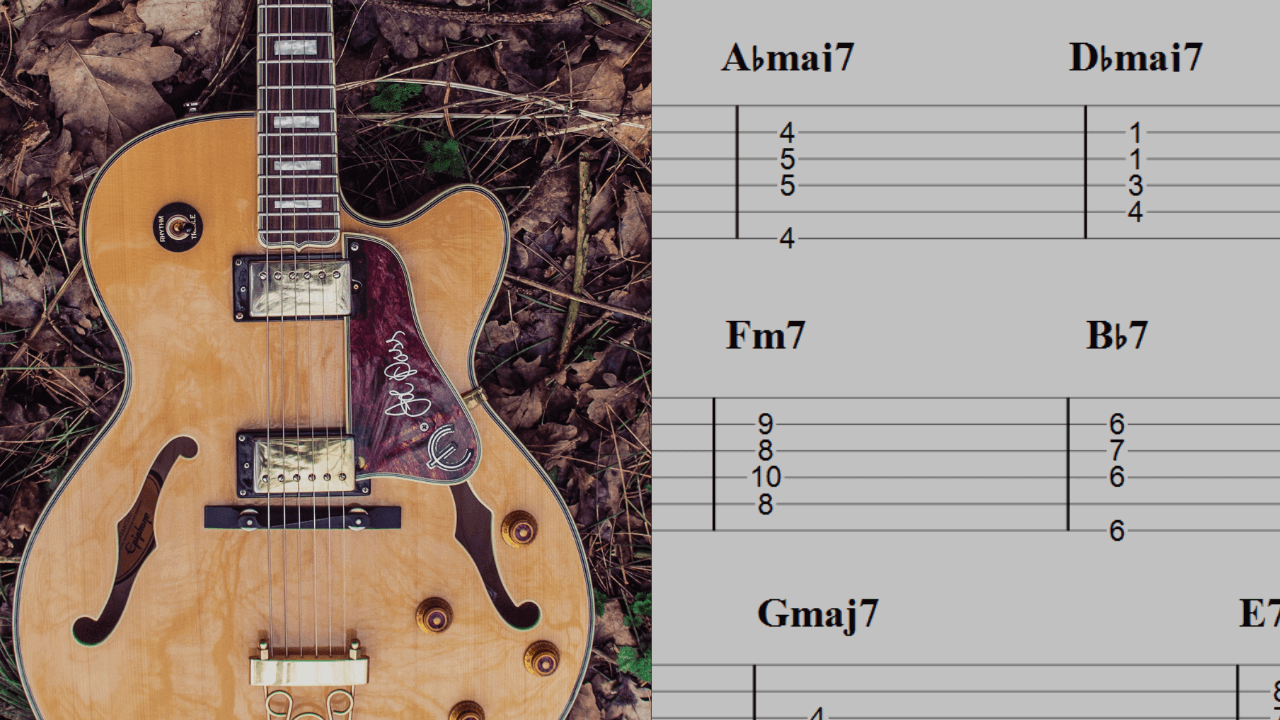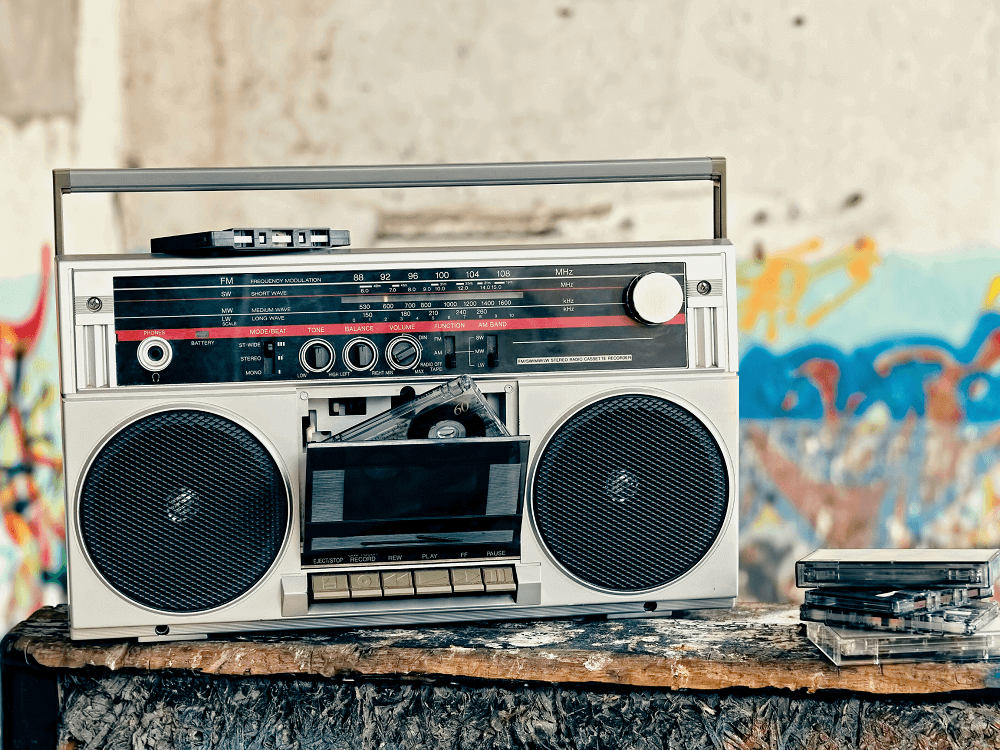What are the best guitar jazz chord progressions?
Outside of classical music, Jazz can easily claim to be the most complicated musical genre of all.
Becoming a competent Jazz guitarist involves making funky note choices over rapid-fire chord changes that won’t stay in key, and then creating melodies that follow all of that, off the cuff.
For this reason and many more, it can be difficult for Jazz guitarists to constantly come up with new ideas.
These chord progressions may help you reconsider that thought, and maybe help you find some inspiration to later use in your guitar playing.
Table of Contents
- Jazz Chord Progressions
- Satin Doll
- Take The A Train
- I’ve Got Rhythm
- Summertime
- All The Things You Are
- Misty
- Minor Swing
- Honeysuckle Rose
- Round Midnight
- Donna Lee
- Blue In Green
- Four On Six
- In A Sentimental Mood
- Blue Bossa
- Samba Triste
- Songs Of The Island
- West Coast Blues
- Autumn Leaves
- Just Friends
- Have You Met Miss Jones?
- The Girl From Ipanema
- Solar
- Mr. PC
- Fly Me To The Moon
Jazz Chord Progressions
Satin Doll
The thing about Jazz chord progressions is that they’re usually very long, and they can get quite complex.
For example, the progression below is only 8 bars, but has 11 different chords!
(Dm7 – G7) – (Dm7 – G7) – (Em7 – A7) – (Em7 – A7) – (Cm/Eb – D7) – (Abm7 – Db7b9 – C6) – (F – Em7) – A7b9

The first thing to notice is the changes from Dm7 to G7 as well as Em7 to A7, which are the very typical chord changes in jazz known as ii-V changes.
This progression is in the key of C major, which means the ii is Dm7 and G7 is the V.
These chords can be found in Duke Ellington’s “Satin Doll,” let’s take a listen to it:
He’s playing the same chords on a piano, which might make it harder for you to realize which chord is which, but if you play them on your guitar, then it’s easier to hear each one individually.
Take The A Train
Another quality that makes Jazz chord progressions sound so good is the exotic chords like Cmaj9, A7#5#9, and Ab13. These chords are known as extended or alt chords.
It would take a much longer article to explain what makes these so unique, but the key thing to keep in mind is that Jazz chords often use 4 or more notes together.
Cmaj9 – D9b5 – (Dm7 – Ab13 – G7) – G7 – (C6/G – A7#5#9) – (Ab13 – G13)

With the ii-V concept in mind, many Jazz chord progressions are looking to do more than just play a Dm chord or a G chord.
They want to play closely related chords that share two or more notes, or that only have one at times.
The reason they do this too is to venture outside of the musical key the song is centered within.
If you know some music theory, you may know that C major only has 3 minor chords and 3 major chords that are “diatonic” to the key, and this progression and several others we’ll be talking about will often use chords outside the key.
The chord progression above comes from another Duke Ellington classic, “Take The A Train.”
I’ve Got Rhythm
This chord progression is a good example to break down major key harmony and understand more how chords usually work together in similar scenarios.
(Bbmaj7 – Gm7) – (Cm7 – F7) – (Bbmaj7 – Gm7) – (Cm7 – F7) – (Bb7 – Bb7/Ab) – (Eb6/G – Ebm6/Gb) – (Bb/F – F7) – Bb

This example comes from George Gershwin’s “I’ve Got Rhythm.” Notice that it too has some ii-V chord changes like the previous examples.
- Bb Major scale notes: Bb – C – D – Eb – F – G – A
- Bbmaj7 (I) = Bb – D – F – A
- Cm7 (ii) = C – Eb – G – Bb
- Eb6 (IV) = Eb – G – Bb – C
- F7 (V) = F – A – C – Eb
- Gm7 (vi) = G – Bb – D – F
I’m aware that I’m overloading you with a lot of theory at this point, but this is truly what makes the progressions work so well together! Look at how every note comes from the scale.
Jazz not only takes advantage of nearly every note in a diatonic key but also likes to use outside notes like the minor 6th interval (Gb in the case of Bb major) and Ab, the minor 7th interval.
Using Bb7, the progression temporarily changes keys, or modulates, to the key of Eb.
Then, finally, the Eb6 and Ebm6/G are very similar to Cm7, which is used as the ii chord (Cm7) to move back to F7. Compare the notes below to make sense of what I’m saying:
- Bb7 = Bb – D – F – Ab (minor 7th interval)
- Ebm6/Gb = Eb – Gb (minor 6th interval) – Bb – C
- Cm7 = C – Eb – G – Bb
Summertime
Here’s another Gershwin progression that’ll help us better understand the concepts we’ve been talking about.
(Am7 – E7/B) – (repeat 5X) – (Dm – F6) – (Dm7/A – Fmaj7/A – Adim7) – (E/G# – B7#9) – (E – Em6/B – Bb9b5)

This song is based on the A minor key, and you should notice some familiar chords if you know this key signature enough.
As we’ve seen, Jazz musicians don’t like to stay inside any specific musical key, they look for new notes and chords to harmonize the melodies and thus have new ways to reinvent any basic chord progression.
Let’s now look at that Bb9b5 and B7#9 a little closer.
- A major scale notes: A – B – C – D – E – F – G
- Am7 (i) = A – C – E – G
- E7 = E – G# – B – D
- F6 = F – A – C – D (major 6th interval)
- B7#9 = B – D# – F# – A – C## (D)
- Bb9b5 = Bb – D – E – Ab (G#) – C
A few more curveballs here, just compare the Bb9b5 to E7 and you’ll see how similar they are.
This is what lots of jazz chords are constantly built upon, they’re just being replaced for another closely related chord!
All The Things You Are
This chord progression in the key of F minor comes from “All The Things You Are” by Jerome Kern & Oscar Hammerstein:
Fm7 – Bbm7 – Eb7 – Abmaj7 – Dbmaj7 – G7 – Cmaj7 – Cmaj7 – Cm7 – Fm7 – Bb7 – Eb7 – Abmaj7 – (Am7b5 – D7) – Gmaj7 – E7#9
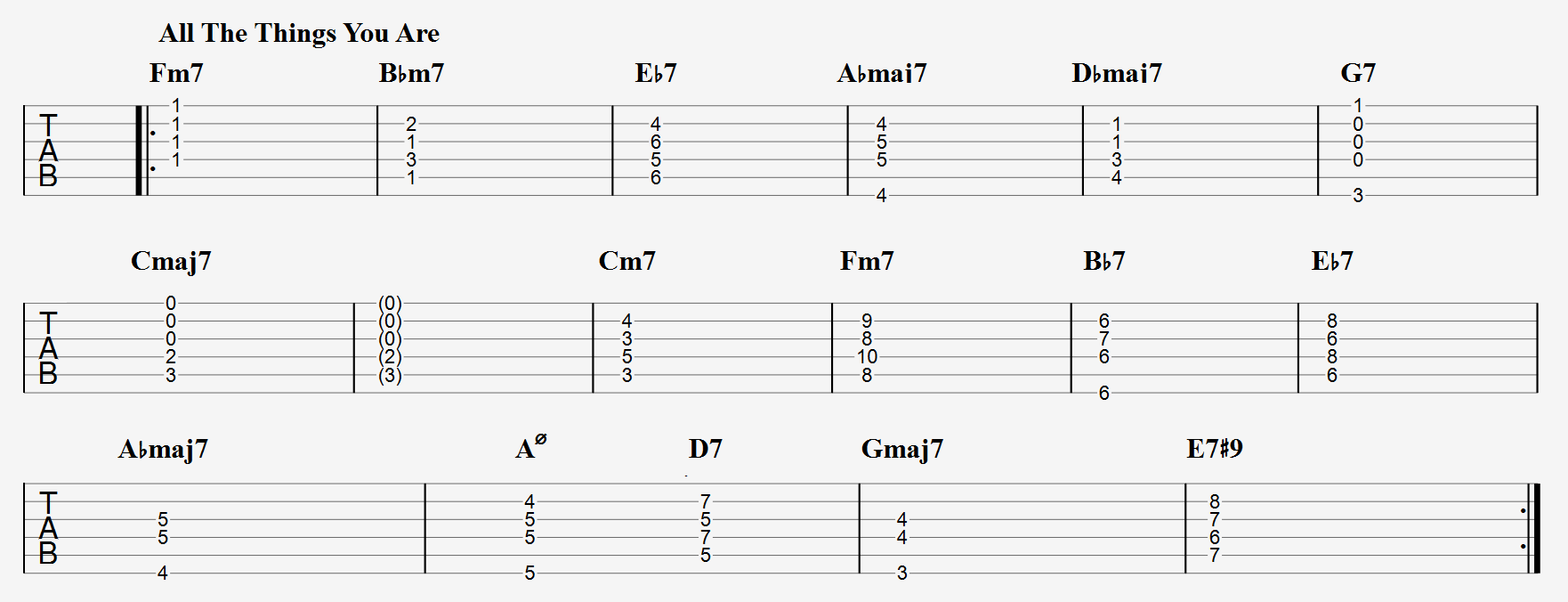
Other than just putting brand new chords from a key that don’t belong there, sometimes progressions also go into a completely new key, in this case, C minor.
To see this, you’ll need to compare some of the chords in each key signature:
- F Minor = Fm (i) Gm7b5 (ii) Abmaj7 (III) Bbm7 (iv) Cm7 (v) Dbmaj7 (VI) Eb7 (VII7)
- C Minor = Cm7 (i) Dm7b5 (ii) Ebmaj7 (III) Fm (iv) Gm7 (v) Abmaj7 (VI) Bb7 (VII7)
Look at where the progression goes from Cmaj7 to Cm7, that’s where this principle is coming into play.
Misty
For this example from Errol Garner’s “Misty” in the key of G major, we’re looking at several ii-Vs changing of keys repeatedly.
Gmaj7 – (Dm7 – G7/D) – Cmaj7 – F7 – (Gmaj7 – Em7) – (Am7 – D7) – (Bm7b5 – E7) – (Am7 – D7)

Remember that all 12 major keys will have their own ii-V changes, therefore in Jazz, it’s inevitable that a composer will want to use it to go around several keys.
Some songs will just use a couple of key changes, while some will be bolder and use a handful of changes.
“Misty” is a jazz standard written in 1954.
It was originally composed as an instrumental following the conventional 32-bar format, the song later had lyrics by Johnny Burke and became the signature song of Johnny Mathis.
Minor Swing
The next two examples are coming from the godfather of jazz guitar, Django Reinhardt, starting with the progression of “Minor Swing.”
(Am – Bm7b5) 3x – Am – Am – Dm – Dm – E7 – E7 – Am – Am – Dm – Dm – Am – Am – E7 – Bb7 – Am – (F7 – E7)
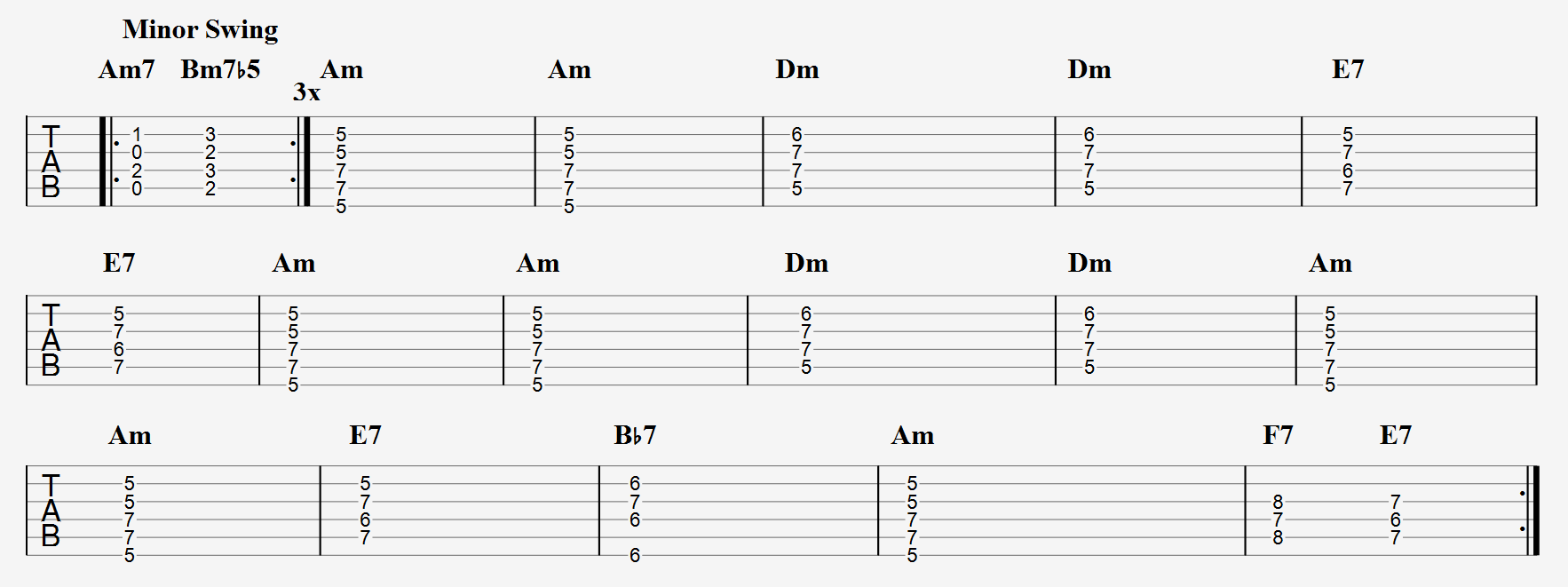
You’ll get a lot of insight into this chord progression by breaking down the A minor key signature, but let’s focus a little bit on a chord that’s appearing a lot: the m7b5 or half-diminished chord.
- Bm7b5 = B – D – F – A
- Dm7 = D – F – A – C
This chord appears naturally in every major key as the vii chord, and as you can see above, it’s a great substitution for both Dm and F chords.
Honeysuckle Rose
Here’s the next Django chord progression, this time from Honeysuckle Rose:
(Gm7 – C7) – (Gm7 – C7) – (Gm7 – C7) – (F6 – F7/A) – (Bbmaj7 – Bm7b5) – (F6 – Bb9) – (Am7 – Abm7)

This chord progression was made during World War II, and the basics of Jazz are obvious right here too.
Notice the m7b5 chord again from the example before.
Round Midnight
Here’s in my opinion one of the coolest jazz progressions ever!
This version is in Eb minor, as played by Wes Montgomery, the great Jazz guitarist.
Ebm – Cm – Fm – Bb7 – Ebm7 – Ab7 – (Bm7 – E7) – (Bbm7 – Eb7) – Abm7 – Db7 – (F#7 – G7) – Ab7 – B7 – B7 – Bb7 – Bb7

To make sense of this chord progression, just break down the diatonic chords in this key, as we’ve done with other keys.
Eb minor chords = Ebm (i) Fm7b5 (ii) Gbmaj7 (III) Abm7 (iv) Bbm7 (v) Cbmaj7 (VI) Db7 (VII)
Donna Lee
This next example is a classic Charlie Parker tune in the key of Ab major that was very popular back in the day.
Abmaj7 – F7 – Bb7 – Bb7 – Bbm7 – Eb7 – Abmaj7 – (Ebm7 – D7) – Dbmaj7 – (Dbm7 – Gb7) – Abmaj7 – F7b9 – Bb7 – Bb7 – Bbm7 – Eb7

Hopefully, you’re still noticing how many jazz progressions don’t stay strictly in key, and I’ll keep repeating the same thing over and over since this idea is very important that you comprehend.
The chords F7, Dbm7, Gb7, Ebm7, D7, and finally Bb7 are all outside the key of Ab major.
Blue In Green
We had to include at least one Miles Davis tune.
Although this one is in C major, several chords are not a part of the key as well, like A7#9, Db7b5, Bbmaj7#11, and E7#5#9.
Gm7 – A7#9 – (Dm7 – Db7b5) – (Cm7 – F7b9) – Bbmaj7#11 – A7#9 – Dm7 – E7#5#9 – Am7 – Dm7

Take note of the Bbmaj7#11, which takes advantage of the sound of the Lydian mode:
- Bb Lydian = Bb – C – D – E (#4/11) – F – G – A
- Bbmaj7#11 = Bb – D – F – A – E
If you take a listen to the official audio track on YouTube it’ll be very easy to spot when this change occurs in the song.
Four On Six
This progression in the key of G minor comes from the great Wes Montgomery as well:
Gm7 (4x) – (Cm – F7) – (Bbm7 – Eb7) – (Am7 – D7) – (Ebm7 – Ab7)

The change in this example happens from G minor to Bb major to G major to Db major.
Yes, that’s 4 different times, and the interesting part is when you start questioning how can a musician manage to make such changes sound appealing to an audience.
As guitar players, we all know that sometimes a simple wrong note when playing a solo will mess everything up and end up sounding awful.
Some people might say that Jazz is the only genre that allows you to make mistakes and have an entire auditorium clapping afterward, but in reality, it all has a reason behind it.
In A Sentimental Mood
And finally, we’ve got one that John Coltrane played, this one is in Bb minor:
Bbm9 – Bbm9 – Ebm9 – (Ebm6 – F7#9#11) – Bbm9 – Bb7#9 – (Ebm – Ab13) – Dbmaj9

Take a look at the chords in the Bb minor key below:
- Bb minor key chords = Bbm (i) – Cm7b5 (ii) – Dbmaj7 (III) – Ebm7 (iv) – Fm7 (v) – Gbmaj7 (VI) – Ab7 (VII)
You can see that most of the ones used in the progression are part of the same key.
That should show how and why the chords above work together so well, and if you’re looking for ideas to use on an original song, then you can start working your way from here.
For example, start changing the key and the exact order in which the chords are being played and you already have a new chord progression.
Blue Bossa
This example is our first bossa nova tune, and this one is in C minor.
Cm6 – Cm6 – Fm9 – Bb7 – Dm7b5 – G7#5#9 – Cm13 – Cm13 – Ebm9 – Ab13 – Dbmaj7 – Dbmaj7 – Dm7b5 – G7#5#9 – Cm13 – (Dm7b5 G7)

Once again, notice again how the song is going outside of the key using chords that don’t belong in C minor, like Ebm9 and Dbmaj7.
If you’re looking to learn to improvise in Jazz, then with this song, in particular, you can study the lead instrument and see how it moves around the different chords being played.
Samba Triste
Here’s another bossa nova example that’s much simpler in the key of C major:
F7 – E – Am – G7

To continue the thread we’ve been talking about with outside chords, notice how F7 and E are not part of the key of C major.
In C major, Fmaj7 and Em are the diatonic chords.
Songs Of The Island
This next progression came from an instructional video I found on YouTube with Barney Kessel.
He was a great Jazz session guitar player who played on hundreds of songs and albums in the 50s and 60s and beyond.
F – F#dim7 – Gm7sus4 – C7 – G7 – C7 – F – D7 – G7 – C7

Particularly, this progression was written in the key of F major, and all the chords stay in the same key for the most part but it does explore notes from other signatures.
https://youtu.be/fnoXbqadcjU?t=1379
I encourage you to watch as much from this video as possible; in the timeframe that we marked it at, he talks about putting your own feeling into what you play.
In other words, they’re moments in which you need to fill spaces in the song and he mentions different ways in which you can do so.
West Coast Blues
Any conversation about Jazz guitar is going to have several references to Wes Montgomery, and for that reason, I’ve got another progression for you:
Bb7 – Bb7 – Ab7 – Ab7 – Bb7 – Bb7 – Bm7 – E7 – Eb7 – Eb7 – (Ebm7 – Ab7) – (Dm7 – G7) – (Dbm7 – Gb7) – (Cm7 – F7) – (Cm7 – F7) – (Bbmaj7 – Db7) – (Gbmaj7 – B7)
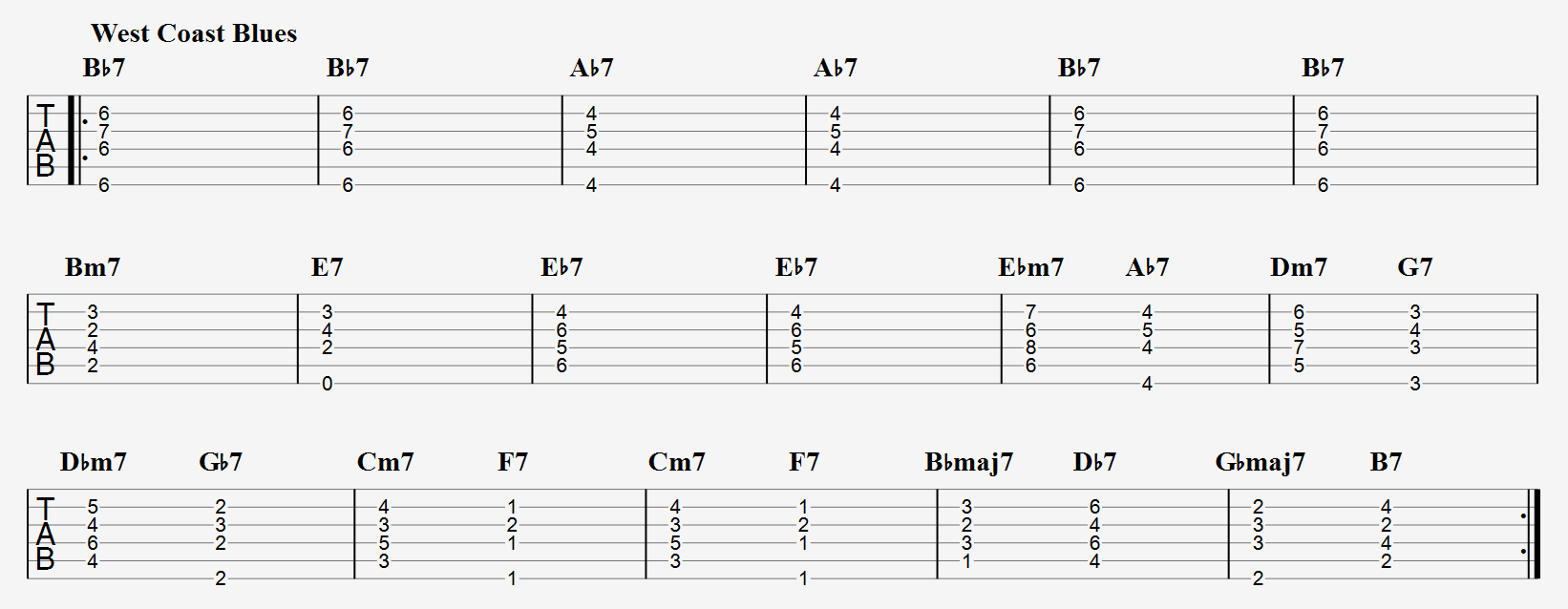
As you can see, this Jazz progression is rather long, so it makes a lot of sense that it’s very rich and full of fundamental jazz playing concepts.
Try to find several of the things we’ve talked about before: key changes, ii-V chord changes, and outside chords.
Autumn Leaves
Any search for jazz guitar on Youtube is going to have lots of covers of this standard as it’s set in the perfect key for a guitar, E minor:
Am7 – D7 – Gmaj7 – Cmaj7 – F#m7b5 – B7 – Em

This is a great chord progression for beginners; notice that many of the chords above are easy to play in the open position.
Most of the time, Jazz won’t be a very beginner-friendly genre, so this is one of those examples that allow new players to be introduced to this type of music.
Just Friends
This next progression in the key of G major is another standard that has been covered by many of the people we already mentioned like Miles Davis and John Coltrane:
Cmaj7 – Cmaj7 – Cm7 – F7 – Gmaj7 – Gmaj7 – Bbm7 – Eb7 – Am7 – D7 – Bm7 – Em7 – A7 – A7 – Am7 – (D7 – Db7)
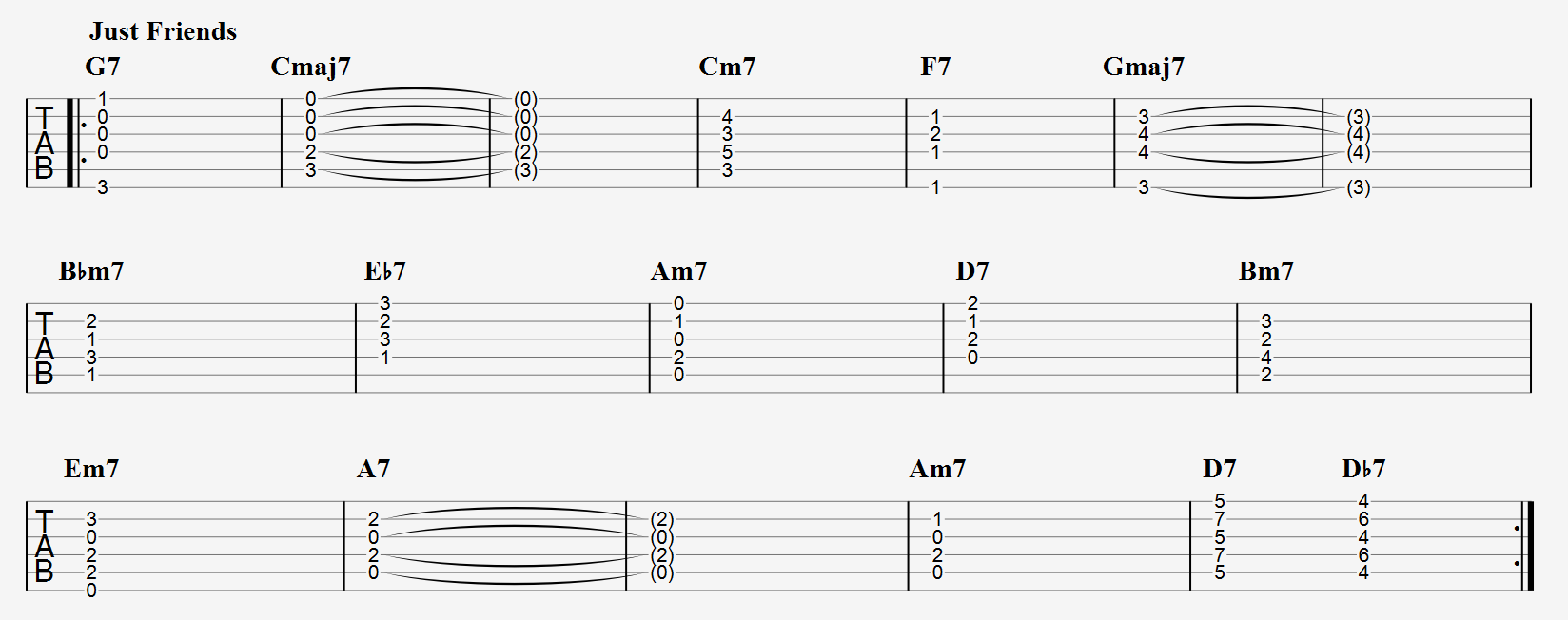
In this case, let’s do something different from what we’ve been doing so far.
Let’s focus on the singing part instead of the guitar playing itself.
You might wonder how can a person sing with all these keys changing constantly and all these different notes being played at all times.
With the help of this YouTube video, we’re able to hear this clearly, there’s always going to be a point in which the singer is out of key, just like a certain note or a chord would be.
Have You Met Miss Jones?
This is another tune, in the key of F major, that has a sort of bossa nova feel.
Notice again that this is one of the few examples with a diminished 7th chord:
Fmaj7 – F#dim7 – Gm7 – C7 – Am7 – Dm7 – Gm7 – C7

At the same time, most of these chords can also be played in open string positions, so this is a great way to practice this part of the guitar fretboard.
If you’re a beginner, there are only two chords that can give you some trouble, and that is Fmaj7 and Gm7.
For these two, you can play them using simplified versions, or by not using a barre chord at all.
The Girl From Ipanema
And now we’ve got the ultimate classic bossa nova tune that Frank Sinatra famously covered:
Fmaj7 – Fmaj7 – G7 – G7 – Gm7 – Gb7b5 – Fmaj7 – Gb7b5

The Gb7b5 chord is a great alternative to use because it’s basically a variation of C7.
- Gb7b5 = Gb – Bb – D (flat 5th) – Ab
- C9 = C – E – G – Bb – D
On this cover, the song is played in the key of F Major, but this varies depending upon the origin of the recording.
The original tune was a worldwide hit in the mid-1960s and won a Grammy for Record of the Year in 1965.
Solar
This song has been a favorite for many beginner Jazz guitarists to solo over.
The reason is that the first few bars stick mostly to Cm7 and Fmaj7, and the key changes aren’t too hard to prepare for.
Cm7 – Cm7 – Gm7 – C7 – Fmaj7 – Fmaj7 – Fm7 – Bb7 – Ebmaj7 – (Ebm7 – Ab7) – Dbmaj7 – (Dm7b5 – G7b9)

When it comes to the primary key signature, you’ll hear many variations depending on the recording, but most of the time, the song will be in the key of C minor.
Mr. PC
There are lots of great tunes by John Coltrane, but I included this one because, if you’ve made it this far, you may be getting a little overwhelmed by the long progressions and many chords.
Once again, this one is also in C minor, so it’ll be a great tune to solo over after “Solar.”
Cm7 – Cm7 – Cm7 – Cm7 – Fm7 – Fm7 – Cmadd9 – Cm7 – Ab7 – G7 – Cmaj7 – G7

This is a 12-bar jazz piece in minor blues form, composed in 1959.
The song is named in tribute to the bass player Paul Chambers who had accompanied Coltrane for years.
Fly Me To The Moon
The last progression we’re going to cover is another classic tune from Frank Sinatra.
Despite the many chords, it actually sticks fairly close to the key of A minor.
Am7 – Dm7 – G7 – (Cmaj7 – C7) – F6 – Bm7b5 – E7 – (Am – Am7 – A7) – Dm7 – Dm7 – G7 – (Em7 – A7) – Dm7 – (Dm7 – G7) – (Cmaj7 – C/G – C6) – (Bm7b5 – E7b9/G#)

Some new chords in this one include the F6 and C6.
While this is a very long jazz chord progression, you’ll notice that is very simple in terms of the types of chords being played and the phrasing used.

An avid storyteller and music lover that devotes all his free time to mastering the art of playing guitar. I’ve played acoustic for 6 years, and recently started playing electric guitars. Currently playing an Epiphone SG Special!

